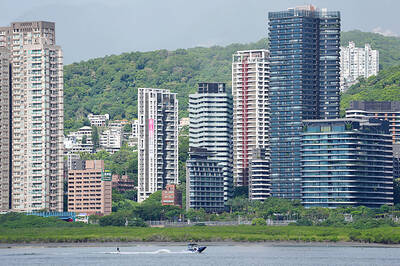China’s massive earthquake is expected to bring down the nation’s soaring economic growth this year by at least 0.2 percentage points, state media said yesterday.
The May 12 earthquake will lead to a one-month production stoppage and curb consumption in worst-hit Sichuan and some neighboring areas, the China Securities Journal reported, citing domestic economists.
But the impact is likely to be short-lived and the quake could eventually boost investment, a major driver of China’s economic growth, through reconstruction efforts, it said.
“Although the quake disaster will have a negative impact on growth in the economy and on corporate earnings in the second quarter, the impact would be a short-term one,” said Zhu Jianfang (朱建方), an economist with CITIC Securities (中信證券).
China’s economy, the world’s fourth-largest, grew 10.6 percent in the first quarter from a year earlier after expanding by 11.4 percent last year, the fifth consecutive year of double-digit economic growth.
Zhu, who expected the quake to strip 0.2 percentage points off economic growth this year, said the economy would return to normal growth in the third and fourth quarters.
Another Chinese brokerage, BOC International China (中銀國際證券), expected the quake to lower annual growth in GDP this year by 0.4 percentage points to to 0.7 percentage points, the report said.
The direct economic losses caused by the quake will be “much larger” than the fierce snowstorms that hit China in January and February, the report said, citing Fan Jianping (范劍平), economist with the State Information Center, a government think tank.
Sichuan’s GDP last year was 1.05 trillion yuan (US$150.1 billion), accounting for about 4.3 percent of the country’s economy, official figures showed.
Economists note that the financial impact of the disaster would have been much more severe had the earthquake struck the bustling eastern coastal regions, the manufacturing base for China’s lucrative exports.
But even though the overall impact on growth is seen as limited, the earthquake in the heavily agricultural region may prolong a spike in inflation.
The annual growth of the consumer price index (CPI) rebounded to 8.5 percent in last month, after hitting a near 12-year high of 8.7 percent in February but weakening to 8.3 percent in March.
“Post-earthquake reconstruction may add a further increase to investment and economic growth in coming quarters, but headline CPI inflation may also be prolonged by some of the earthquake effects”, said Wang Qian (王黔), a Hong Kong-based economist at JPMorgan Chase Bank.
“We expect monetary policy to stay nominally biased toward tightening, in order to keep inflation expectations in check,” she said in a research note yesterday.
China has raised the amount of money banks must keep in reserve four times so far this year in a bid to curb credit growth and help curb inflation.
But state media has reported that the central bank exempted banks in six quake-hit cities from the latest increase in reserve requirements, effective from today, to help keep money ample for relief work.
ON THE FARM
Meanwhile, the government said last week’s quake killed 12.5 million farm animals — mostly chickens — and wrecked vegetable crops and irrigation systems needed to grow rice.
More than 20,000 hectares of vegetables and more than 10,000 hectares of wheat were destroyed by the quake, the Agriculture Ministry said.
Damage to irrigation systems could prevent farmers from growing rice on as much as 100,000 hectares of rice paddies, the ministry said. But it said that land might be used for alternative crops while the damage is repaired.
Most of the farm animals killed were poultry, Deputy Agriculture Minister Wei Chaoan (危朝安) said in comments reported by the Xinhua news agency.
He said the losses should not affect food supplies, because they account for a small share of the 1.5 billion birds that Sichuan Province was expected to produce this year.
Sichuan usually supplies about 6 percent of China’s grain and 5 percent of its vegetables, Wei said.

RECYCLE: Taiwan would aid manufacturers in refining rare earths from discarded appliances, which would fit the nation’s circular economy goals, minister Kung said Taiwan would work with the US and Japan on a proposed cooperation initiative in response to Beijing’s newly announced rare earth export curbs, Minister of Economic Affairs Kung Ming-hsin (龔明鑫) said yesterday. China last week announced new restrictions requiring companies to obtain export licenses if their products contain more than 0.1 percent of Chinese-origin rare earths by value. US Secretary of the Treasury Scott Bessent on Wednesday responded by saying that Beijing was “unreliable” in its rare earths exports, adding that the US would “neither be commanded, nor controlled” by China, several media outlets reported. Japanese Minister of Finance Katsunobu Kato yesterday also

Taiwan’s rapidly aging population is fueling a sharp increase in homes occupied solely by elderly people, a trend that is reshaping the nation’s housing market and social fabric, real-estate brokers said yesterday. About 850,000 residences were occupied by elderly people in the first quarter, including 655,000 that housed only one resident, the Ministry of the Interior said. The figures have nearly doubled from a decade earlier, Great Home Realty Co (大家房屋) said, as people aged 65 and older now make up 20.8 percent of the population. “The so-called silver tsunami represents more than just a demographic shift — it could fundamentally redefine the

China Airlines Ltd (CAL, 中華航空) said it expects peak season effects in the fourth quarter to continue to boost demand for passenger flights and cargo services, after reporting its second-highest-ever September sales on Monday. The carrier said it posted NT$15.88 billion (US$517 million) in consolidated sales last month, trailing only September last year’s NT$16.01 billion. Last month, CAL generated NT$8.77 billion from its passenger flights and NT$5.37 billion from cargo services, it said. In the first nine months of this year, the carrier posted NT$154.93 billion in cumulative sales, up 2.62 percent from a year earlier, marking the second-highest level for the January-September

Businesses across the global semiconductor supply chain are bracing themselves for disruptions from an escalating trade war, after China imposed curbs on rare earth mineral exports and the US responded with additional tariffs and restrictions on software sales to the Asian nation. China’s restrictions, the most targeted move yet to limit supplies of rare earth materials, represent the first major attempt by Beijing to exercise long-arm jurisdiction over foreign companies to target the semiconductor industry, threatening to stall the chips powering the artificial intelligence (AI) boom. They prompted US President Donald Trump on Friday to announce that he would impose an additional